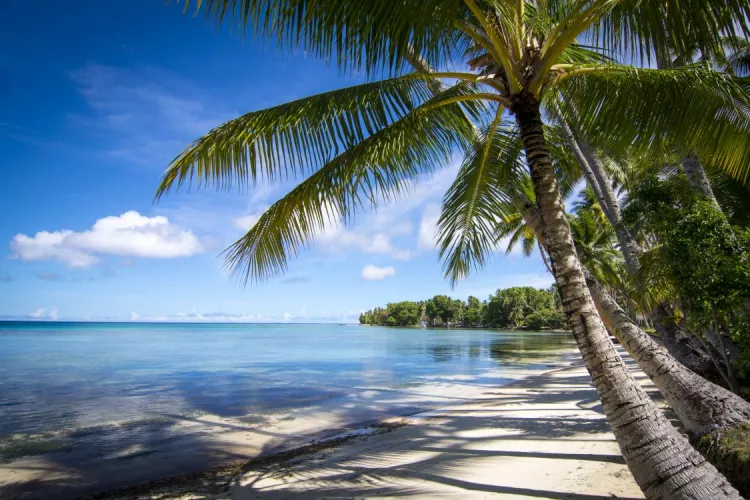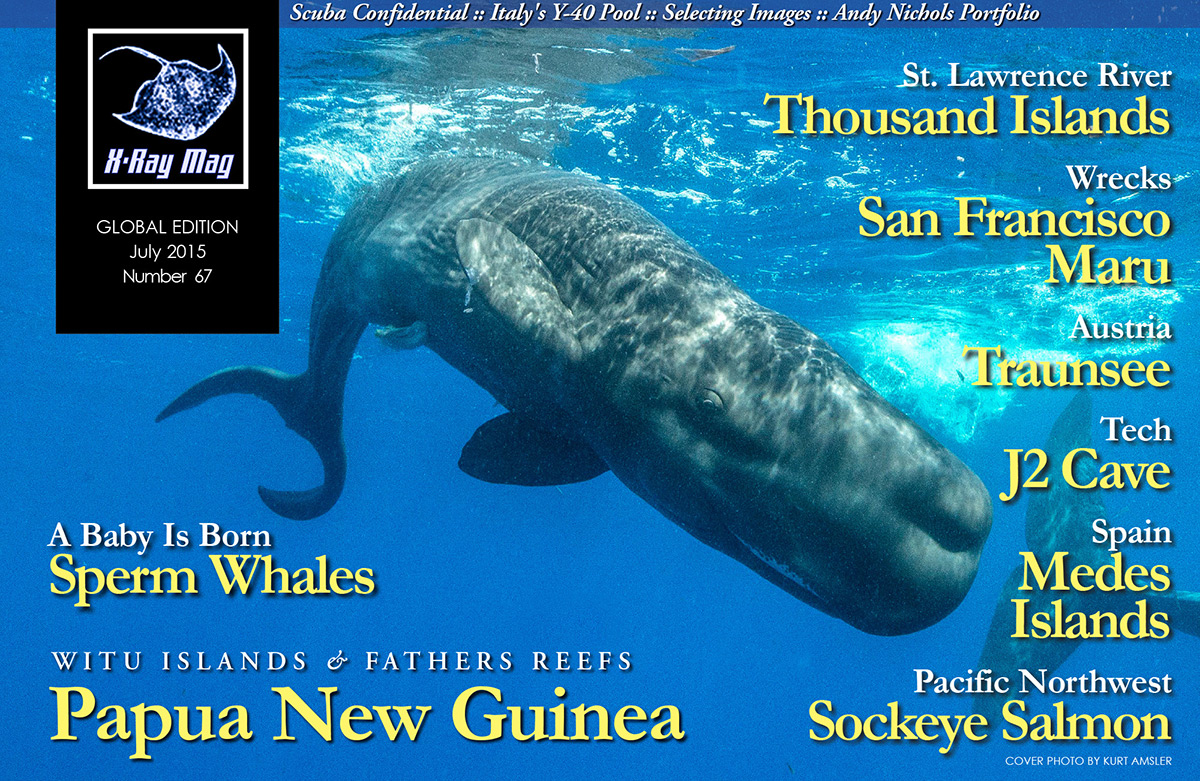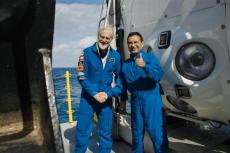Truk Lagoon (now known as Chuuk) plays host to what is usually considered the world’s best wreck diving. World War II ships, planes, tanks, trucks, and military artifacts abound at recreational dive limits in Micronesia’s calm, warm waters. The abundant marine life has transformed the former war vessels into stunningly beautiful artificial reefs.
Contributed by
Factfile
Brandi Mueller is a PADI IDC Staff Instructor and U.S. Coast Guard Captain living in the Marshall Islands.
When she’s not teaching scuba or driving boats, she’s most happy traveling and being underwater with a camera.
For more information, visit: www.brandiunderwater.com.
REFERENCE: World War II Wrecks of the Truk Lagoon by Dan E. Balley
With so many interesting wrecks, it can be hard to choose a favorite. But ask any wreck diver who has been to Chuuk and most likely they will tell you their favorite is the San Francisco Maru. The ship is popularly referred to as the “Million Dollar Wreck” because it was (and still is) chock-full of expensive cargo including tanks, trucks, mines, ammunition, aircraft bombs, torpedoes and depth charges.
The San Francisco Maru is also popular because of its depth. Sitting in the sand around 62m (205ft), the top deck is at 50m (165ft), and shallowest parts of the ship are the two masts at 32m (105ft). Most of the interesting cargo can be seen between 50m and 56m (170-185ft), putting the wreck technically out of recommended dive depths for recreational divers.
That being said, local dive operators will lead small groups for dives with short bottom times (and short deco times) while carrying extra air and staging tanks throughout the dive in case of emergencies. With good visibility and little current, the dive has relatively easy diving conditions other than depth, often being the deepest dive most recreational divers have ever done. For trained tech divers, the ship is a fantastic tech dive with plenty to explore and makes for a great training technical dive as well.
The ship
The San Francisco Maru was built in 1919 to join a fleet of over 50 identical cargo ships owned by Yamashita Kisen K. K. that were involved in world trade. It was commissioned into the Japanese Imperial Navy during WWII and was used to transport war materials between Japan and its Pacific Island territories and occupied islands. The freighter was 117m (385ft) long with an 8m (27ft) beam and 5,831 gross tons.
Prior to arriving in Truk, the San Francisco Maru suffered damage from an attack at Wewak, New Guinea on 4 May 1943. From there, it went to Inoshima docks for repairs. The ship arrived in Truk on 5 February 1944.
Operation Hailstone
As of 1944, Truk was a territory of the Japanese and an important operations base for the Japanese Combine Fleet. On 16-18 February 1944, the United States launched a massive naval air and surface attack on Truk. Known as Operation Hailstone by the United States and Torakku-tō Kūshū (the airstrike on Truk Island) by the Japanese; the US military invaded Truk with forces that included five fleet carriers, four light carriers and over 500 planes.
Prior to the attack, the Japanese realized the vulnerability of having so much of their fleet in one place. Just a week before Operation Hailstone, they relocated many of their aircraft carriers, battleships and heavy cruisers to Palau. Despite this action, the United States’ attack by air, ship and submarine seemed to have taken Japan by surprise and Operation Hailstone sank three Japanese light cruisers, four destroyers, three auxiliary cruisers, two submarine tenders, three other warships and 32 merchant ships. Over 250 Japanese aircraft were destroyed, most of which were on the ground being assembled having just arrived in cargo ships still in pieces. The United States lost only 25 aircraft and the attack crippled Japanese forces.
The San Francisco Maru had arrived in Truk on 5 February 1944 and stayed even when its convoy sailed on 12 February 1944. The ship was shown in a photograph to be anchored southeast of Dublon Island in the 4th Fleet Anchorage (just east of Eten Island) on 17 February 1944.
The 4th Fleet Anchorage was attacked on Feb 17, but the San Francisco Maru did not appear to be harmed on the first days of the air strike. But on 18 February 1944, a TBF Avenger from the USS Essex, an amphibious assault ship, dropped a 500-pound bomb that hit midship, starting a large fire. The ship was seen devoured in smoke and flames and it sank stern first. Five members of the crew were lost.

The dive
The first report of finding the San Francisco Maru underwater came from Cousteau’s Truk Expedition in 1969, but it was not dived again until 1973 when a group of Kwajalein-based divers re-discovered it. They identified it by the ship’s bell and the name etched on the side of the bridge superstructure.
Since then, the San Francisco Maru has become a very popular dive, even with (or maybe because of) its depth. The ship rests upright in the sand at around 62m (205ft) in a relatively calm area with good visibility. Liveaboards and day boats moor to one of two mooring balls connected to the wreck which allow divers to follow the lines down to the ship. Divers descend into the blue and usually cannot see any part of the wreck for the first 15m (50ft). The first view of the ship is usually one of the two large, intact masts.
Continuing to descend down the forward mast, divers will notice that this ship has very little marine growth on the wreck in comparison to the other wrecks. This is most likely because of its depth and has left the ship still looking very much “ship-like” as it did over 75 years ago instead of encrusted with sponges and corals like many of Chuuk’s other shipwrecks.
Once divers reach the top deck, the ship turns into a playground for wreck-lovers. One of the first sights is of two Japanese Light Tanks on the starboard side of the deck. One sits partially on top of the other (probably either due to the impact of the bomb or the ship hitting the seafloor). Directly across the deck on the port side is a third tank.
The tanks are Mitsubishi manufactured Japanese Light Type 95 HA-Go tanks with half-inch armor. They would have been manned by three people and could move up to 30mph. Each weighed 7.5 tons and had three guns: one 37mm main armament turret gun in the front and two 7.7mm turret machine guns in the back. The tanks were powered by six cylinder air-cooled 110-120hp Mitsubishi diesel engines.
Next to the two tanks on the starboard deck is a 1.5 ton 4x2 Isuzu Type 94 flatbed truck also on the ship’s main deck. The tanks and the truck are just above hold #2 which contains two more partially collapsed trucks resting on the upper tween decks. Below them, fuel drums, ammunition and aircraft bombs can be seen.
Moving forward towards the bow, hold #1 is worth checking out because it is filled with mines. Sadly, many have been removed by the locals to be stripped of the high explosive gunpowder and used in dynamite-style fishing. Those that remain are a unique sight and a highlight of the dive. Hold #1 also contains crates filled with detonators and large coils of cable.
At the bow is a 75mm (3-inch) bow gun that points off the port side. Mounted on a platform with very little growth, it looks as if it could still be used today if necessary. By swimming just a little off the port side of the bow, divers can see (or swim to) a large steamroller sitting in the sand at 62m (205ft). It likely fell off the ship during impact.
Most divers, especially non-tech divers, divide the ship into at least two dives and tackle the stern portion of the wreck in a second dive.
Moving towards the aft of the ship, damage from the 500-pound bomb that hit the aft superstructure is visible around midship. Hold #4 has torpedoes stacked as well as single torpedoes that appear to have been tossed around, also probably due to the bomb impact or the sinking. There are also depth charges, anti-aircraft ammunition, shells and mines.
At the stern, there used to be lantern storage in one of the doghouses, which has collapsed, so several lanterns in various conditions have been placed on the deck.
Throughout the ship, divers can also find non-weaponry artifacts including cups and saucers with the markings of the ship’s owners and other china. Beer bottles, cooking utensils, medicine bottles, binoculars and more can also be found.
Overall, the San Francisco Maru, is in considerably good shape bearing in mind it has been underwater since 1944. Its depth has prohibited some of Micronesia’s prolific marine life from growing on the ship, leaving it very much how it looked when it originally sank. Due to its depth and that there is so much to see, the ship is best explored in several dives or as a technical decompression dive by those trained to do so.
When diving the San Francisco Maru, be sure to take into consideration one’s personal training and limits, and give adequate time to plan the dive and carry out that plan underwater. With the extensive ordinance on the ship, be careful not to disturb it and be aware of narcosis and decompression, which can both play a role on this dive.
The San Francisco Maru, also known as the “Million Dollar Wreck”, is one not to be missed while diving in Chuuk. Any diver will be thrilled having seen tanks, trucks, mines, depth charges and torpedoes all on one dive while also potentially breaking their own personal dive depth records.
On 29 March 2015, the last day of my trip, Typhoon Maysak directly hit Chuuk and did considerable damage to the islands. Please keep the people of Chuuk in your thoughts as they recover and rebuild from this natural disaster that has caused considerable damage to their island; as well as those in other places affected by Maysak.■























































